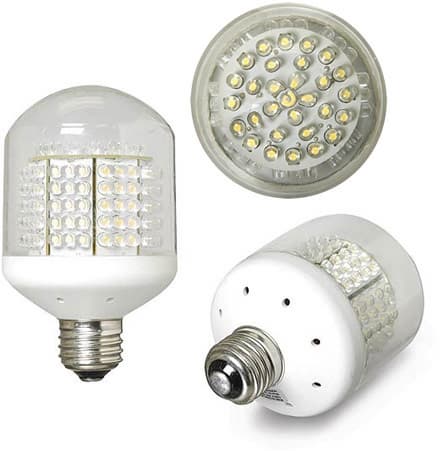|
|
1. The Incandescent Light Bulb
Incandescent bulbs are the same type of light bulb built (not invented) by Thomas Edison back in 1879 (Did you know Thomas Edison Did Not Invent The Light Bulb). The incandescent light bulb has many different shapes, as do all of the common light sources of this article, but incandescent bulbs tend to be glass like clear, round, and have a fine piece of wire bent into zigzags in the center. The zigzag piece is called a filament. When the filament is heated by electrical current it emits light and heat. Incandescent bulbs are still in use today, but are the least energy efficient of the three bulbs we will compare. |
| Various types of CFL light bulbs |
2. The Compact Fluorescent Light Bulb (CFL)
This is the lightbulb that has been gradually replacing traditional incandescent bulbs in recent years. The CFL bulb is spiral shaped (most often) and is considered eco-friendly by the majority of people. These bulbs have been recorded to save 80% more power than incandescent bulbs. But, a big problem with CFL bulbs is that they contain about 5 mg of mercury per bulb. Enough exposure to broken CFL bulbs could present serious health problems such as brain cancer.On the upside, CFL bulbs can save you money on your power bill. On the downside, CFL bulbs need to be used with more care than the standard incandescent bulb.
  |
| LED bulbs Source |
3. The LED Light Bulb (LED = Light Emitting Diode)
LED stands for Light emitting diode and is an important component for modern day electronics and environmentally friendly standards on the rise. Most appliances and devices that have lights built in with them show that they are powered (turned on) with a bright red or green LED. LEDs are not limited to the colors red and green, and are powered by D.C. (direct current) electricity. The LED type light bulb is a collection of the relatively small (5mm / 0.05cm diameter), LEDs. LED-type light bulbs are the most effecient at converting electrical energy to radiant (light) energy. However, the thermal energy lost in incandescent bulbs served a greater purpose that was long misunderstood.So,
the big question is...
WHICH IS THE REAL "LIGHT" BULB?
Incandescent: aprx. 90% thermal energy and 10% radiant (light) energy
CFL: aprx. 60% thermal energy and 40% radiant (light) energy
LED: aprx. 10% thermal energy and 90% radiant (light) energy
Clearly the LED is the most efficient at converting electical current into radiant (light) energy as oppsed to the incandescent that is more a "thermal" bulb than it is a light bulb. In between the two is the CFL (compact fluorescent light bulb).
 |
| Snow on LED traffic lights = big problem |
The Problem with LEDs in Traffic Lights
Street lights are on all day and all night directing traffic, regardless of the season. In winter the incandescent bulbs work well, so why would not the LED type do the same in addition to saving energy and money. Well, in winter it snows, and street lights get covered in snow, leaving street lights unrecognizable. Incandescent bulbs melt the snow off due to its 90% thermal energy conversion, but LEDs do not have enough thermal energy to do so. Since, that initial problem, streetlights in some areas in the United States have little hat like over hangs to keep snow from blocking LED street lights.
Another problem involving the decrease in thermal energy from light bulbs is that houses will need to power their homes with more AC (air control) and heat to reach desirable temperatures in the winter and fall, in which would crank up an ugly energy bill.




No comments:
Post a Comment